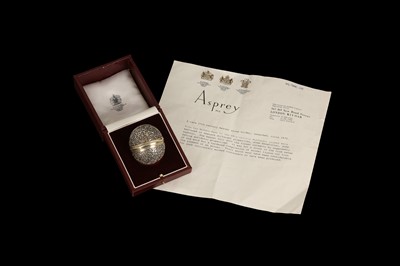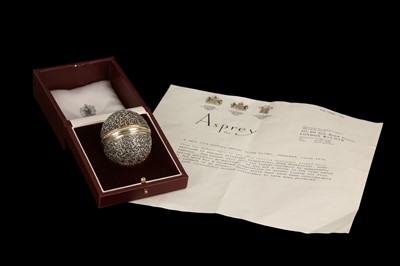30th Jun, 2021 14:00
The Collector: Objects to Clocks
A RARE GILT AND SILVER GILT BEZOAR STONE HOLDER
PROBABLY GUJARAT OR GOA, LATE 17TH / EARLY 18TH CENTURY
A RARE GILT AND SILVER GILT BEZOAR STONE HOLDER, PROBABLY GUJARAT OR GOA, LATE 17TH / EARLY 18TH CENTURY
decorated throughout with piereced interlacing flowers and foliage, with a floral rosette to the top and another to the bottom, both gilded, the border holding the two domed sections together also gilded, with a bespoke gilt tooled, leather case from Asprey, and accompanying paperwork from Asprey,
4.8cm high, 42g weight.
Provenance: Asprey, 165-169 New Bond Street, London. Their paperwork catalogues the piece as 'A rare 17th century bezoar stone holder, unmarked, circa 1670'.
It is said that in the 16th and 17th century, Bezoars were more valuable than gold and were often mounted in elaborate gold and silver holders in medieval treasuries. They were believed to possess quite extraordinary supernatural powers including being a universal antidote, potentates fearing death by poisoning from the Shahs of Persia to The Holy Roman Emperors would anxiously dip theirs in their drinks. The Sixteenth Century French Royal Physician Amboise Pare was something of a skeptic who unusually for his day liked to experiment to see what treatments worked and did not work; wishing to test the efficacy of a Bezoar he procured a cook who had been sentenced to death for stealing silver and made him drink a poisoned draught in which Pare dunked a bezoar on the promise of his life if he survived. He spent seven hours in agony before dying, however whilst Pare was convinced others merely muttered that he had used the wrong type of poison and carried on convinced of the bezoar’s power.
By the 17th century genuine bezoars were being extremely scarce, and so a group of Portuguese Jesuits living in Goa produced their own Goa stones, which were 'a concoction of Bezoar, Ambergese, Pearl, unicorn horn, coral and such other of the greatest cordial preservatives.' Goa stones were believed to be the 'corroborates and renewers of strength and youth', as well as being antidotes for poison.
For comparison see the British Museum: 1978,1002.804 and the Science Museum (London) A66178.
Sold for £4,750
Includes Buyer's Premium
Do you have an item similar to the item above? If so please click the link below to submit a free online valuation request through our website.





